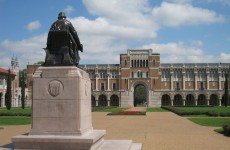When the Houston Independent School District Board of Trustees tentatively voted to ban the use of racially based mascots and nicknames at its schools during its Dec. 15 meeting, its actions joined a several-decade old trend of American schools and sports franchises de-emphasizing or eliminating logos and nicknames associated with negative racial stereotypes.
The 40-year-old pattern has its roots in the Civil Rights movement, but it has picked up momentum as pressure from Native American activists and other groups have found increasingly receptive audiences among state and local policy-makers, as well as other national organizations like the NCAA.
Historical Shifts
Several types of mascot have tended to attract protest in the United States. Those with associations to the Confederate cause of the Civil War draw criticism – like the University of Mississippi’s Rebels, while Coachella High School in California currently faces pressure to withdraw its “Arab” mascot that detractors argue slurs people of Middle Eastern descent.
However, logos and nicknames associated with Native Americans are the most widespread in the United States and draw correspondingly the most attention. According to an October 2013 report issued by the National Congress of American Indians, roughly 3,000 American high schools, colleges and professional sports franchises used native American imagery, nicknames or mascots in the early 1970s.
A 2012 report for the Oregon Board of Education notes that many of those names had been adopted between 1930 and 1960, at the tail end of U.S. policies that confined most Native Americans to reservations, denied them American citizenship and forbade the practice of cultural and religious traditions. As a result, most of the mascots embraced white stereotypes of American Indian with little or no tribal participation. As government policy toward Native Americans eased in the middle of the twentieth century, however, fewer teams embraced native logos, (and began moving from cartoonish representations to more dignified ones) with the last notable franchise adopting such a nickname was the Kansas City Chiefs in 1963.
Starting in 1968, the NCAI, allied with other civil-rights organizations, like the National Association for the Advancement of Colored People and the Anti-Defamation League, began pushing sports teams to drop Native American logos, nicknames and mascots that the NCASI argued demeaned Native peoples. Over the last 40 years, the ACAI report notes that roughly two-thirds of those groups of the original 3,000 organizations with native mascots have dropped them, while a separate report from the Oregon Board of Education identifies 600 schools that have abandoned native mascots during that similar time.
The trend has accelerated over the last 15 years as several state government and national organizations have pressed schools to remove racially based logos. In 2005, the National Collegiate Athletic Association forbade racially based mascots during post-season competition which forced more than a dozen schools to change their mascots, joining numerous colleges that had previously dropped native-themed nicknames and logos.
Currently, the only NCAA-affiliated colleges and universities with Native American mascots are the Florida State Seminoles, the Utah Utes and the Central Michigan Chippewa, all of whom have the official approval and cooperation of the local tribal organization to use the names.
In Oregon, the state board of education used its power to enforce state anti-discrimination laws in school districts to ban Native-American based mascots and stereotypes in 2012. According to an administrative report to the board recommending the policy, the use of such stereotypes in the state had already declined from 27 high schools in 1975 to 12 in 2012.
In 2009, Wisconsin passed Public Act 250, which allowed individual residents of school districts to file a complaint with the state superintendent of education about local mascots. If the superintendent determined the logo was racially based, then the district had to remove it. Districts that refused to come into compliance could be fined up to $1,000 a day for failing to change the logo. (The law still exists but was weakened by the state’s Republican legislature and governor in 2013. Now a resident protesting the logo needs to get a petition signed by 10 percent of the district residents to force a hearing.)
The boards of education in New Hampshire (2002) and Michigan (2003) have also voted to strongly encourage high schools across their respective state to renounce racial imagery in school mascots, while the Indian affairs commissions in Tennessee, Nebraska and North Carolina pass similar resolution. Legislation has also been introduced in Colorado, California and Oklahoma to ban Native American mascots, though in none of these cases have the bills come up for votes. Finally, the United States Civil Rights Commission also condemned the use of Native American images or nicknames for sports logos in 2001.
What’s the problem?
For many defenders – often alumni of the schools in question – the push to remove mascots incorporating native or ethnic imagery is perplexing because they argue that the mascots aren’t meant to be stereotypical but rather to honor native heritage and bring people together – much like schools with nicknames, such as the “Irish” honor the legacy of Irish Catholics. Take Sergio Ortega, a student and football player at Cochealla High School, whose mascot is the Arab.
“It’s pure pride, you know?” he told NPR in an interview. “My parents, my grandparents, they’ve been Arabs, and I don’t see nothing wrong with it! It’s just to show us that we’re strong. We’re strong Arabs, you know?”
Or take Joe Koch, a 1968 Lamar graduate who was quoted in the Houston Chronicle as telling the HISD Board of Trustees that “These names were not meant to be offensive. They were meant as a rallying cry to bring students together.”
Proponents of removing the native imagery counter with three points.
First, as the Oregon Board of Education’s report notes, most schools sponsoring Native American nicknames have a very low percentage of students who are actually of Native American Heritage. In contrast, a team like Notre Dame embraced its own mascot with a student body that was primarily Irish Catholic, giving them a say in their own depiction. Second, since the late 1800s (and certainly in the twentieth century), the numerous U.S. Citizens of Irish heritage have enjoyed a considerable amount of political power regionally and nationally. In contrast, Native Americans have had little political power, which exacerbates the fact that native mascots are dictated to Native Americans as a source of control rather than by them as a source of pride.
Finally, empirical research suggests that these mascots cause measurable psychological harm to the peoples they are depicting. Experimental work by psychologists Stephanie Fryberg, Hazel Markus, Daphne Oyserman and Joseph Stone found in a 2008 study that exposure to stereotypical ethnic mascots and logos lowered self-esteem and perceptions of native community worth among Native American high school students. The study also found, in line with studies on other racial groups, that seeing the common stereotypes limited students’ sense of what they thought they could do with their lives.
This emotional damage may seem minor to some, but paired with the stiff challenges that many Native Americans face – higher poverty and suicide rates, for example – it has the potential to exacerbate problems for Native youth, according to the NCAI report.
What’s next for Houston?
Locally, HISD’s new policy will do away with the current nicknames of Lamar High School (Redskins), and Hamilton Middle School (Indians) for the 2014-2015 year, and possibly force changes to the mascots of Welch Middle School (Warriors) and Westbury High School (Rebels). Schools will have the right to choose new nicknames in line with district policy.
HISD Superintendent Terry Grier, who had pushed for the change partially in response to an open letter from State Sen. Rondey Ellis, argued in a Dec. 7 Houston Chronicle Op-ed the change was ultimately about practicing the ideals that HISD attempts to instill in its students.
“As parents and educators, we teach our children that when others are hurt by our words or actions, even if it’s unintentional, we should stop saying or doing those things. Once someone tells us we’ve hurt them, we have two options. We can shrug and tell them to get over it, because, after all, we didn’t mean to hurt them. Or we can show some empathy and change,” he wrote.














